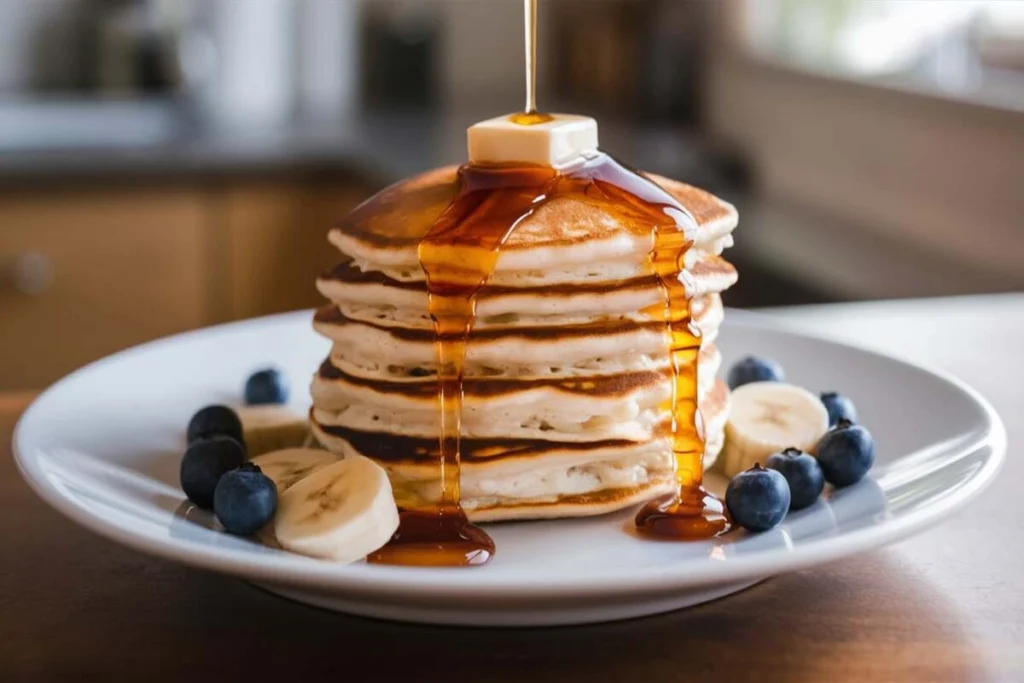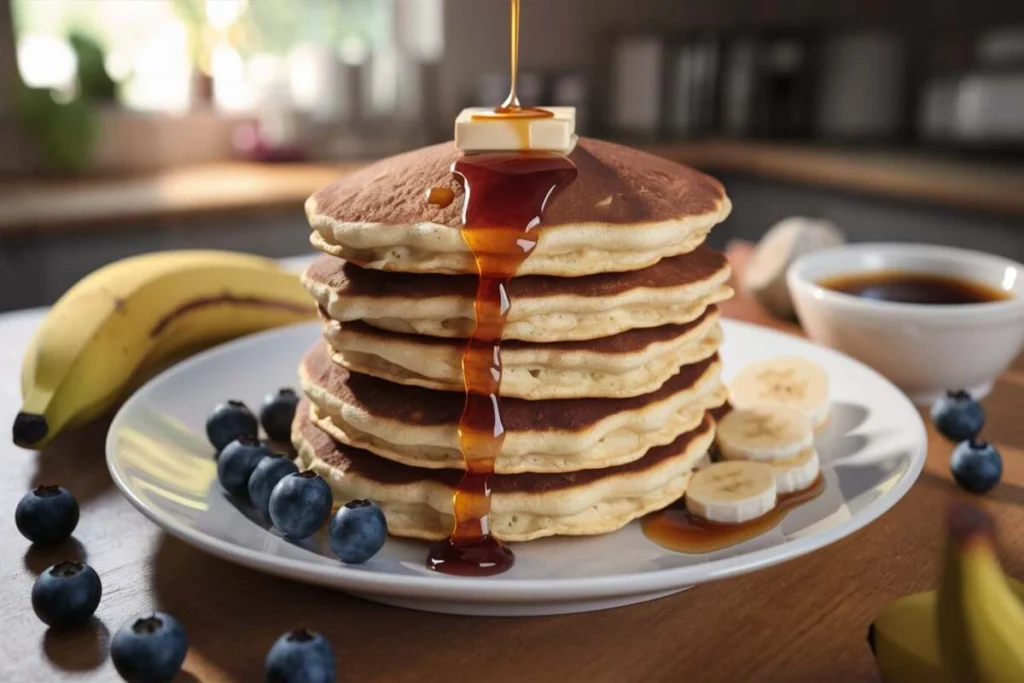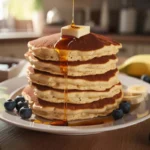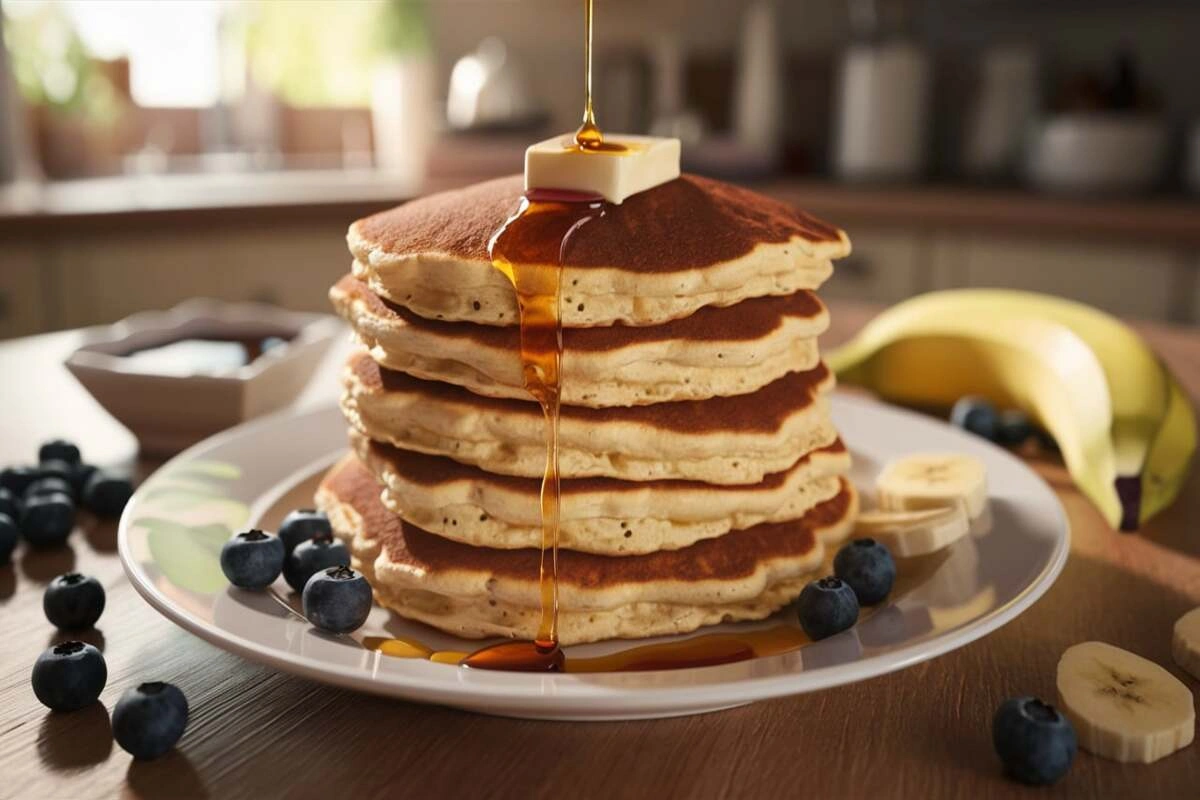Table of Contents: Pancake Recipe No Milk
Introduction: Pancake Recipe No Milk
Who says you need milk to make fluffy, mouthwatering pancakes? Whether you’re dairy-free, out of milk, or just craving something new, this Pancake Recipe No Milk – Easy & Delicious is here to save your mornings. Picture this: golden-brown stacks with crispy edges and pillowy centers, ready in under 20 minutes. No complicated steps, no fancy ingredients—just pure breakfast magic.
Fun fact: The first pancakes date back to ancient Greece, where they were made with wheat flour, olive oil, and honey. Fast-forward to today, and we’re skipping the milk and the hassle! This recipe is perfect for busy parents, college students, or anyone who wants a fuss-free breakfast that feels indulgent. Plus, it’s as versatile as our reader-favorite Classic Buttermilk Pancakes—but with a dairy-free twist! Ready to flip your morning routine? Let’s dive in.
What is Pancake Recipe No Milk – Easy & Delicious?
Ever stared into an empty fridge and thought, “Milk? What milk?” Same. That’s how this Pancake Recipe No Milk – Easy & Delicious was born—a hero for pantry raids and lazy Sundays. Why “No Milk”? Because life’s too short to run to the store mid-pancake craving.
Is it secretly a pancake rebellion? A dairy-free manifesto? Nah—it’s just genius simplicity. As the old saying goes, “The way to a man’s heart is through his stomach,” and these pancakes will win over everyone (yes, even picky toddlers). Ready to make breakfast legends out of basic ingredients? Grab your spatula—it’s time to flip!
Why You’ll Love This Pancake Recipe No Milk – Easy & Delicious

- Dairy-Free Fluffiness: No milk? No problem! A clever mix of water, oil, and vinegar mimics buttermilk’s tang and lift.
- Budget-Friendly: Skip pricey dairy substitutes—this recipe costs less than $5 to make.
- Flavor Freedom: Top with maple syrup, fresh berries, or even chocolate chips. (Psst: Try our Vegan Banana Pancakes next for another twist!)
Perfect for meal prep or lazy weekends, these pancakes are your ticket to a stress-free, crowd-pleasing breakfast. Ready to taste the magic? Let’s get mixing!
How to Make Pancake Recipe No Milk – Easy & Delicious
Quick Overview
- Prep Time: 5 mins
- Cook Time: 10 mins
- Total Time: 15 mins
- Key Features: Crispy edges, fluffy centers, and endless topping options.
Key Ingredients
- 1 ½ cups all-purpose flour
- 3 ½ tsp baking powder
- 1 tbsp sugar
- ¼ tsp salt
- 1 ¼ cups water
- 3 tbsp vegetable oil
- 1 tbsp white vinegar (or lemon juice)
- 1 tsp vanilla extract
Step-by-Step Instructions
- Mix Dry Ingredients: Whisk flour, baking powder, sugar, and salt in a bowl.
- Create “Faux Buttermilk”: Combine water, oil, vinegar, and vanilla. Let sit 2 mins.
- Combine: Pour wet mix into dry ingredients. Stir until just combined (lumps are okay!).
- Cook: Heat a non-stick pan over medium. Pour ¼ cup batter per pancake. Flip when bubbles form.
- Serve: Stack ‘em high and add your favorite toppings!
What to Serve With Pancake Recipe No Milk – Easy & Delicious
- Classic: Maple syrup + butter
- Fruity: Fresh strawberries + whipped coconut cream
- Savory: Crispy bacon + scrambled eggs
- Decadent: Nutella drizzle + crushed hazelnuts
Pair with a cold glass of almond milk or a hot cup of coffee!
Top 5 Flavor Hacks
- Cinnamon Sugar Swirl: Sprinkle cinnamon-sugar on batter before flipping.
- Blueberry Blast: Toss frozen blueberries into the batter.
- Lemon-Zest Glow: Add lemon zest to the mix for a citrusy kick.
- Chocolate Chip Bliss: Fold in dairy-free chocolate chips.
- Savory Herb Twist: Add chopped chives + black pepper (trust us).
Storing and Reheating Tips
- Fridge: Store in an airtight container for up to 3 days.
- Freezer: Layer pancakes between parchment paper; freeze for 2 months.
- Reheat: Microwave 20 seconds or toast for crispy edges!
FAQs: Pancake Recipe No Milk – Easy & Delicious

- Can I make these pancakes gluten-free?
Absolutely! Swap all-purpose flour for a 1:1 gluten-free blend (like Bob’s Red Mill). Just ensure your baking powder is gluten-free too. - What can I use instead of vinegar?
Lemon juice works perfectly! For a neutral flavor, try apple cider vinegar or skip it entirely—just add an extra 1 tbsp of water. - Can I prep the batter the night before?
We don’t recommend it—the baking powder activates as soon as it hits liquid. For faster mornings, mix dry and wet ingredients separately, then combine when ready to cook! - Why are my pancakes dense instead of fluffy?
Overmixing is the culprit! Stir the batter until just combined (lumps are okay). Also, ensure your baking powder isn’t expired. - Are these pancakes vegan?
Almost! Just swap the sugar for coconut sugar (some granulated sugars use bone char) and use dairy-free chocolate chips for toppings.
Conclusion: Why This Recipe Deserves a Spot in Your Breakfast Rotation
Let’s be real: mornings are chaotic. But with this Pancake Recipe No Milk – Easy & Delicious, you’ve got a secret weapon that’s faster than drive-thru coffee and tastier than cereal. No milk? No fancy gadgets? No problem. Whether you’re feeding a hungry family, meal-prepping for the week, or treating yourself to a lazy weekend stack, these pancakes deliver every time.
They’re proof that simplicity and flavor can coexist—crispy edges, cloud-like centers, and endless ways to customize. From cinnamon swirls to savory herb twists, this recipe isn’t just a meal; it’s a blank canvas for your cravings.
So, next time your fridge looks empty, remember: all you need is flour, water, and a dash of creativity. Whip up a batch, tag us with your masterpiece (#NoMilkMagic), and let’s redefine breakfast, one fluffy pancake at a time. Happy flipping! 🥞
Print
EASY Pancake Recipe No Milk
- Total Time: 15 minutes
- Yield: 8 pancakes 1x
- Diet: Vegetarian
Description
Fluffy, dairy-free pancakes that require no milk! Crispy edges, tender centers, and ready in 15 minutes. Perfect for breakfast or brunch—customize with sweet or savory toppings!
Ingredients
- 1 ½ cups all-purpose flour
- 3 ½ tsp baking powder
- 1 tbsp granulated sugar
- ¼ tsp salt
- 1 ¼ cups water
- 3 tbsp vegetable oil (or melted coconut oil)
- 1 tbsp white vinegar (or lemon juice)
- 1 tsp vanilla extract
Instructions
- Mix Dry Ingredients: In a bowl, whisk flour, baking powder, sugar, and salt.
- Make “Faux Buttermilk”: Combine water, oil, vinegar, and vanilla. Let sit 2 minutes.
- Combine Wet & Dry: Pour wet ingredients into dry mix. Stir until just combined (lumps are okay!).
- Cook Pancakes: Heat a non-stick pan over medium heat. Pour ¼ cup batter per pancake. Flip when bubbles form on the surface (1-2 minutes per side).
- Serve: Stack warm pancakes and top with syrup, fruit, or your favorite add-ins!
Notes
- Gluten-Free: Use a 1:1 gluten-free flour blend.
- Vegan Option: Swap sugar for coconut sugar and use dairy-free chocolate chips.
- Storage: Keep leftovers in an airtight container for 3 days or freeze for 2 months.
- Pro Tip: Don’t overmix the batter—fluffy pancakes need a few lumps!
- Prep Time: 5 minutes
- Cook Time: 10 minutes
- Category: Breakfast
- Method: Stovetop
- Cuisine: American
Nutrition
- Serving Size: 2 pancakes
- Calories: 220
- Sugar: 3g
- Sodium: 320mg
- Fat: 7g
- Saturated Fat: 1g
- Unsaturated Fat: 5g
- Trans Fat: 0g
- Carbohydrates: 34g
- Fiber: 1g
- Protein: 4g
- Cholesterol: 0mg
Keywords: pancake recipe no milk, dairy-free pancakes, easy breakfast, fluffy pancakes, no milk recipe

